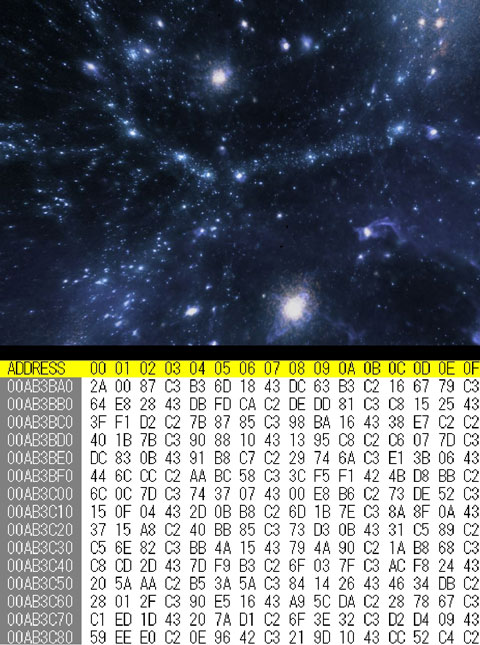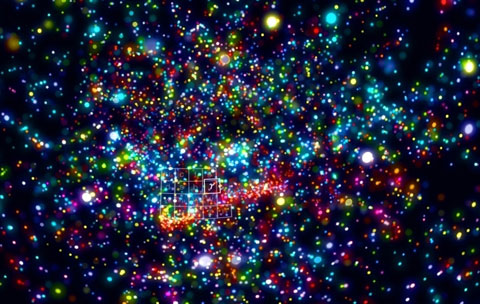This powerful scene depicts the instant when protons moving at high speed in a particle accelerator collide with one another, and visualizes the observation of the Higgs particle in an experiment that was actually conducted in the Large Hadron Collider (LHC) at the European Organization for Nuclear Research (CERN), which possesses the largest particle accelerator in the world.
The scene of elementary particles produced in the collision experiment scattering around, was created by extracting the coordinates (length, width, height) of the elementary particles from the experiment data, and sketching their trajectory using computer graphics.

In the scene showing the “rewinding” of the universe, which traces 13.8 billion years in the history of the Universe in just 2 minutes, from the Big Bang to the present day, the blue-colored earth that floats in outer space moves away rapidly, and we return instantaneously to the moment of the Big Bang.
Pay attention to the cosmic counter that appears at the bottom of the screen in this scene.
The counter begins at 13,800,000,000 (13.8 billion years), and approaches the instant of the Big Bang at O, the beginning of time. As the Universe rewinds, we can see galaxies forming, stars getting born and the energy of the Big Bang solidifying as elementary particles. Here, through the scientific supervision of Prof. Ooguri, we worked to ensure that the visuals matched the time shown on the counter as accurately as possible.

The scene showing the “rewinding” of the Universe (upper photo) was created using the latest scientific data provided by the Illustris Project. Prof. Ooguri helped us get connected to this project, which is undertaken by a scientific team comprising multiple research institutions including Harvard University and the Massachusetts Institute of Technology. It is a faithful recreation and simulation of the history of the universe that spans 13.8 billion years, from the point immediately after the Big Bang (1.2 million years later) to the present day. Gravity, fluid mechanics, thermodynamics, and other complex processes have been taken into consideration, and the historical course of several thousand galaxies was traced on a powerful supercomputer.
The original data comes in the form of binary data (bottom photo), and at first glance, it appears to be no more than a string of digits; however, a wide range of information is packed into these digits, including the properties of stars and gas such as their coordinates, density, and temperature. However, as it is not possible for us to “see” this information in binary data format, they have been processed into an appropriate format. In this work, we have extracted information about dark matter, the light of stars, and the density of gas, and drawn out images showing the cycles of birth and death of the stars.

The superstring theory predicts that there are nine dimensions of space. Of these, three are our three-dimensional space, expressed as length, width, and height. The remaining six dimensions are folded and compactified very tightl, and we cannot perceive them directly.
We also tackled the challenge of visualizing the Calabi-Yau space. The CG/VFX team developed an application that was nicknamed the “Calabi-Yau simulator” (upper photo) especially for this film. The 6-dimensional Calabi-Yau space was projected to 3-dimensional space using mathematical equations used in research, in order to produce a 3D visualization of this scientific concept. By inputting numerical values into the application as parameters, and changing the values by sliding the controller, it is possible to change the form of the Calabi-Yau space freely. Based on the forms created using this simulator, visual effects such as shapes and colors were added to achieve the representation of the Calabi-Yau space as a fluffy character that floats around.

Visual expressions that give an artistic representation of scientific concepts, such as the behavior of elementary particles, were produced by synichi Yamamoto, the Visual Director of the film, and the team of artists that was responsible for the CG/VFX. Neutrinos (top photo) are generated in various locations, including the sun, supernova explosions, and inside the Earth. In this work, neutrinos pouring forth from the sun are presented as a colorful shower. By changing the colors of the particles in the downpour to blue, green, and red, the film attempts to visualize neutrino oscillations. In the scene where the Higgs particle is introduced (bottom photo), elementary particles pass through the Higgs field and because of that they slow down. Once they are out of the Higgs field they return to their previous speed. This scene was created having a “traffic jam” in mind.

Generally, when we hear about the Big Bang, we often imagine an explosive expansion starting from a specific point accompanied by a “bang.” In this film Mr. Yamamoto, kept the essence of the scientific background while trying to create an expression for the Big Bang beyond the norm. He created an elaborate sequence of still images and made the bold decision to use no sound in order to create a never before seen, avent-garde depiction of the Big Bang. Prof. Ooguri had provided advice concerning the Big Bang, explaining that “this explosion took place uniformly in the Universe as a whole and not in a specific place”. The “world of nothing” that existed before the Big Bang (bottom photo) can be thought of as the most abstract image presented in this work. How could we create the image of a world that nobody has seen before? After a trial-and-error process lasting several months, we arrived at an abstract image that provides a glimpse of something that is slightly concrete and material. This original and innovative concept of the “world of nothing” was created by incorporating the sensation that there is “something present even when there is nothing there,” which is the feeling we get when we pass by a large tree in the park on a dark night.

